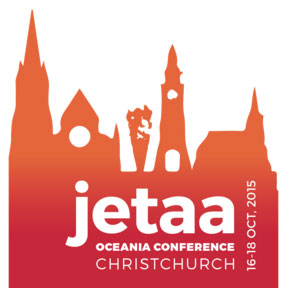JQ Magazine: Book Review — ‘The JET Program and the US-Japan Relationship: Goodwill Goldmine’
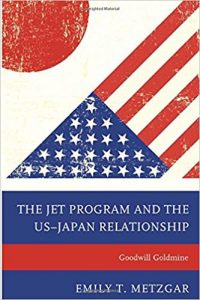
“While focused solely on the American experience, the outline of the history and intention behind the JET Program’s creation is a fascinating and illuminating one. One hopes that this book will be the start of the conversation and academic study on JET’s other accomplishments and help complete the picture of a fallible but venerable institution.” (Lexington Books)
By Eden Law (Fukushima-ken, 2010-11) for JQ magazine. Eden is the current JETAA New South Wales President (in Sydney, Australia) and Australian JET Alumni Association Country Representative, and handles the social media/website side for JETAA International as Webmaster. He also runs the Life After JET podcast.
Note: Spelling is always problematic when dealing with international differences. I shall be spelling “Program” the way it is referred to in the book and the title, to avoid inconsistencies. Apologies, especially to any fellow Australians reading this. However, I’ll be keeping my quixotically placed “u”s and “r”s.
Created in 1987, The JET Program has brought tens of thousands of young people from around the world to work, live and experience life in Japan. An international exchange program of a diplomatic nature, its aims were to improve global perceptions towards Japan and to internationalised Japanese local communities, all through the format of teaching and improving English skills in schools. Since then, articles and papers about the effectiveness of JET has focused primarily on its impact (or lack thereof) on the level of English language ability on the student population, leading to questions about the feasibility of maintaining the high costs of the program. At least once, the program came close to termination: In 2010, a Japanese government budget review panel called for the discontinuation of JET, before the subsequent administration of Shinzo Abe saved it, setting the agenda for expanding numbers in the lead-up to the 2019 Rugby World Cup and the 2020 Tokyo Olympics.
More positive literature exists, of course: David L. McConnell’s Importing Diversity: Inside Japan’s JET Program, published in 2000, is the most well-known example, written by an academic who was once a JET participant. Seventeen years on, Emily T. Metzgar (Shimane–ken, 1993-95), herself also once a JET and now an academic, has penned a follow-up of sorts, entitled The JET Program and the US-Japan Relationship: Goodwill Goldmine, which, as described in its title, confines its evaluation of the program on its international impact in relation to the United States and Japan. The JET Program justifies its restricted focus on this bilateral relationship on its assertion that the program was originally created with the United States in mind as the first target for Japan to improve its international image abroad. Statistically, 50 percent of the total number of participants throughout the program’s history have been sourced from the United States (and in an impeccable sense of timing, the book arrived on the eve of the program’s big 30th anniversary celebrations and JETAA conference in Washington, D.C., featuring Metzgar as one of the headline presenters).
Commentators seeking to put a more positive outlook on the program’s accomplishments have had to look outside of the hoary old topic of education. The JET Program settles on examining how it worked as a “soft power” initiative for Japan’s global image (the topic of how JET fared as an internationalisation agent of Japanese local community is, as Metzgar says, best left “as a promising research topic for an ambitious doctoral student,” though she does comment on these other aims later on). For those wondering, yes, the book argues that JET has been enormously successful in this aspect. Examples are plentiful in The JET Program: recalling the threat of JET’s culling high-profile American JET alumni in organisations such as the American Enterprise Institute (AEI) and JCIE/USA defended it by referring to its “soft power” success. In other less fraught periods, the book cites senior members and policymakers of both governments who spoke positively of JET’s contributions to their countries’ relationship, implying acknowledgement of the same thing.
JQ Magazine: JQ&A with Julia Inisan, CLAIR Programme Coordinator
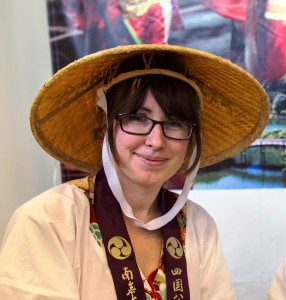
“JET Programme participants are in a very good position to match supply with demand by bringing people together, and there are many great examples of ALTs, CIRs and SEAs using crowdsourcing, social networks, recorded videos, and event planning to support their local community.” (Courtesy of Julia Inisan)
By Rashaad Jorden (Yamagata-ken, 2008-10) for JQ magazine. A former head of the JETAA Philadelphia Sub-Chapter, Rashaad is a graduate of Leeds Beckett University with a master’s degree in responsible tourism management. For more on his life abroad and enthusiasm for taiko drumming, visit his blog at www.gettingpounded.wordpress.com.
Julia Inisan (Kagawa-ken, 2013-15) first visited Takamatsu City, the capital of Kagawa Prefecture in Shikoku, in 2011 on a two-week tea ceremony study tour. That excursion served as a life-changing experience for the Frenchwoman as she fell in love with the city and decided to apply for a spot as a CIR there.
As a JET, Inisan has established herself as a valuable member of her local community, working diligently to attract tourism to the area and promote it on a global stage. But Inisan’s work in Japan has been far from limited to just Shikoku: She currently works to support the next generation of JETs as a programme coordinator for CLAIR. JQ caught up with her to discuss her history and blossoming career in Japan.
What attracted you to Japan in the first place?
As an elementary school student, I was fascinated by mythology and folklore and started reading classics like the Kojiki (Records of Ancient Matters) translated into French. I was also moved by the aesthetics expressed in works such as Murasaki Shikibu’s novel The Tale of Genji and Hayao Miyazaki’s movie Princess Mononoke, and I decided to study Japanese in high school to learn more about the archipelago’s traditional culture.
I then had the opportunity to study for one year at Higashi High School in Kitakata, where I fell in love with Fukushima Prefecture’s gorgeous landscapes, and later at Kyoto University, another life-changing experience. What kept me coming back each time was the kindness of the locals, which helped me feel at home despite the cultural differences.
What made you decide to become a CIR, and what was that like compared with your previous experience living in Japan?
I was a CIR in Takamatsu City from 2013 to 2015. I had always wanted to work for the Japanese local government and promote lesser-known areas of Japan, which is why I applied for the job. As I already had strong connections to Takamatsu, receiving my acceptance letter was one of the happiest moments of my life.
I was Takamatsu City Office’s first CIR. Without a predecessor, it was difficult for me to grasp the extent of my responsibilities at first. Fortunately, I received great advice from the CIRs working at Kagawa Prefecture and from my JET Programme sempai. Finding a good balance between work, volunteering, and private time was also challenging, but my experiences with the local community have been incredibly rewarding.
You currently work as a programme coordinator for CLAIR in Tokyo. How did that opportunity come about, and what kinds of things are you responsible for?
When my two-year contract ended in Takamatsu, my contracting organization encouraged me to apply to be a programme coordinator job at CLAIR. I felt very grateful to the JET Programme and wanted to contribute to its development while supporting Japan’s local communities at a global level. I am learning a lot from my Japanese and foreign coworkers at CLAIR, and most of all from the feedback we receive from JET participants.
I currently work on a wide variety of projects, such as planning content for Post-Arrival Orientations and the CIR Mid-Year Conference, revising publications like the CIR Handbook, and directing workshops at ALT Skill Development Conferences. Last year, I was fortunate to work in cooperation with Kagawa Prefecture to welcome back Sophie Le Berre (CIR Kagawa-ken, 1995-97), one of the 12 JET Programme alumni who returned to their former places of work as part of CLAIR’s Satogaeri Project.
I am also part of the team in charge of the JET Programme Video Contest, which started in October last year. We have received lots of awesome submissions from current and former JET participants promoting their regions from their points of view. I am greatly impressed by the quality and creativity of the videos, which you can view and vote for on the contest’s website. I hope more and more JET participants will participate in this initiative, as these videos are helping tourists discover amazing areas of Japan they’ve never heard of. If you are interested in the contest and missed the deadline for the Autumn/Winter edition, don’t worry: from April 7, 2016, you can still participate in the Spring/Summer edition.
JETs in Academia: Understanding Privacy in Japan
Nathaniel Simmons (Nara-ken, 2007-2009) is currently a communication professor at Western Governors University and lives in Columbus, OH, USA. He teaches a variety of intercultural, interpersonal, and health communication courses. He has researched and published several scholarly articles regarding privacy management between foreign English teachers and Japanese co-workers in Japan and is currently working on turning his research into a book.
What is private in Japan?
If I tell my co-workers I have hemorrhoids, diarrhea, or need to go to the OBGYN will they tell everyone else?
These may not be questions JETs think about when they first go to Japan. It also may not be something JETs consider when they are ill and trying to gain medical care or just discussing information (i.e., relationship status) about themselves with their co-workers.
The reality is Japanese cultural conceptions of privacy might be different than many JETs’ expectations. Depending upon how individualist or collectivist your home country is will influence how privacy is interpreted, expected, and maintained. The concept of “what is private” or “privacy” differs cross-culturally, as do the ways in which privacy values are expressed.
Japan is no exception.
Japan has been largely classified as a collectivistic culture. As you know from your own experiences in Japan, the group matters more than the individual. In other words, in Japan the “we” wants and goals come before the “I” or “me” wants and goals. For collectivists, the very notion of privacy might be viewed as selfish due to an individual’s wants and goals taking precedent over the group’s desires.
Ever notice that privacy is in katakana, the Japanese syllabary used for foreign words? Puraibashi, or プライバシー, is taken directly from the English word for “privacy.” Since traditional Japanese language has no word for privacy, a unique cultural conception of privacy emerged. For example, the idea that one has “the right to be left alone” might signal a lack of cooperativeness with the group and an inability to work well with others. Additionally, controlling one’s privacy information might be perceived as an excess of mistrust. Even Japanese scholars have commented that gaijin might perceive the group interdependence of Japanese people as “suffocating.”
Japanese language use two distinct, yet interrelated meanings of Japanese privacy: shakai ( 社会), or “public,” and seken (世間), or “world/society.” Such terms stress the importance of relationships, interdependence, and group harmony. Shakai contributes to negative aspects of crimes being withheld from the media in order to protect victims and their families. If one was to “break shakai” it would involve speaking publically about private matters which might harm another’s reputation. Seken emphasizes human relations and allows Japanese people the ability to “understand” or at least “explain” what went wrong in a given situation. To the foreign eye, this might look intrusive, or like “gossip,” as one tries to understand one’s home life or culture to explain a tragic event.
As JETs operate on differing values of privacy, this might result in individuals feeling “violated” or “exposed.” Perceived privacy violations can lead to relationship withdrawal, isolation, and negative assumptions/stereotypes about one’s co-worker or Japan in general. Throughout my research, gaijin English teachers reported feeling that their co-workers invaded/violated their privacy expectations. In other words, if they told someone something, it was then told to someone else, who then told someone else…etc. You get the point. In my research, gaijin felt victimized when people knew things about them that they didn’t disclose (i.e., So and so sensei told me you went to the doctor and are on X medication), even if it was something positive (i.e., I heard your dental checkup went well!). My participants felt like “celebrities” because “everyone (i.e., Japanese people)” in their communities knew “everything” about them.
Critics of my participants’ stories have said “Well, they should know it will be different from their home country.” It is easy to say “expect things to be different.” To what extent should this responsibility be shared? No recruiting organizations discuss privacy in their trainings. Perhaps privacy is something so engrained in one’s culture that it is perceived to be “common sense?” Perhaps that “common sense” is where the most difficulties exist when what one “commonly” thinks doesn’t work.
Regardless, this is a collective issue that requires further dialogue and research to better understand how to cultivate meaningful relationships. Several of my participants chose to cut their contracts short or to not renew because of their interpersonal privacy experiences.
That’s costly – it costs financially and personally.
This blog post is an adaptation of the scholarly article: Simmons, N. (2012). The tales of gaijin: Health privacy perspectives of foreign English teachers in Japan. Kaleidoscope: A Graduate Journal of Qualitative Communication Research, 11, 17-38. Retrieved from http://opensiuc.lib.siu.edu/kaleidoscope/vol11/iss1/3/
JET Talks: George Rose – Baseball and the US-Japan Relationship
************
What do people do after JET? Here’s one great example.
On November 16, JETAA DC held the latest in their JET Talks series with a talk by JET alum George Rose (Fukushima-ken, 1989-91), former interpreter for Hideki Irabu and current Director of Pacific Rim Operations for the New York Yankees, not to mention former JETAA NY President.
Here’s a video of the talk. (Thanks to JETAA DC Vice-President Joy Young for passing this on!) Many great anecdotes including one about interpreting for Hideki Matsui on the Regis and Kathy Show. Plus, did you know that George played a role in helping the Yankees sign Masahiro Tanaka? Watch and enjoy!
https://www.youtube.com/watch?v=fuA3cbHacfw
2015 JETAA Oceania Conference: Staying Connected
The JETAA Oceania Regional Conference took place in Christchurch, New Zealand this year, over the weekend of Oct 16th-18th. JETAA Oceania is a meeting of chapters from two countries, Australia (5) and New Zealand (3), as well as the respective country representatives. Australia’s Country Representative, Eden Law (ALT Fukushima 2010-2011) reports on the proceedings of the 2015 JETAA Oceania Conference.
As far as I know, the JETAA Oceania Regional Conference is unique in the JETAA world, where two countries share an annual convention – not surprising, considering the geographical proximity and historically close relations (buddies and often times frenemies) of Australia and New Zealand. This year’s theme is “Staying Connected” – to past and present JETs and JET community, local Japanese organisations and cultural groups, sister city initiatives and of course, with other chapters. Because it’s such a core issue to many chapters, we had a lot to say, discuss and share – opinions, ideas and examples that have work and didn’t. Some ideas:
- Maintaining connections with new JETs by following up after a month to see how they are going. If you have a newsletter, ask for article contributions (e.g. “Best experience”, “Most surprising aspect”, “What I should have packed”). These can also be used as material for the next pre-departure orientation.
- Have a committee retreat – have a mini conference by going away to a nice country location to discuss ideas, plan schedule etc.
- Provide some kind of charity work opportunity to give a sense of purpose and satisfaction
- Market JET Programme as a way to gain transitional skills (e.g. being bilingual means you can see things from different viewpoints)
- Sell JET as a professional development program
- For a fun fundraising idea, have a trivia night where answers/clues can be bought for a small fee. Cheat for charity!
This conference also marks my presentation debut as a shiny, newly minted country representative, which was also the same for my New Zealand equivalent, Raewyn MacGregor. Our presentations were about what we’d do as CRs, considering that the role tended to be re-invented to suit each new candidate’s needs and personality. Apart from trying to reduce the wheel-reinvention aspect by keeping records and procedure documentation, we will also aim to focus on community and communication. To that end, I put forward a proposal to have regular, scheduled Google Hangouts for Oceania to keep in touch and continue the flow of dialogue, ideas and support for each other (and if possible, get some participants from outside Oceania to join in!). We will also look at ways of supporting recent returnees, whether in the form of support, mentorship or career opportunities.
We also discussed the Satogaeri Project and the Tokyo November conference, where Satogaeri representatives from several countries (and AJET) will meet and discuss several ideas, such as next year’s 30th Anniversary celebratory plans, and, most interestingly of all, the possible revival of JETAA International (JETAAI). This chapter had gone dormant for the last few years since losing funding during austerity measures implemented by previous governments. For some of you out there, you may be aware of (or have participating in) the short bursts of email communications regarding this chapter. From the documentation presented by CLAIR at the conference, it’s now clear why this was occuring, as JETAAI’s revival looks fairly certain, with proposed committee members election to be held (presumably with those present). There are other further surprising items on the agenda regarding country representatives, so I’ll await the post-conference report with interest.
On a final note, it became clear that the common ingredient running through all successful ideas was networking – building and maintaining relationships which can be tapped into for opportunities. This does require work and commitment – as is the case with anything worthwhile. You can’t go at it half-arsed if you intend to make things a success, after all. Special thanks go to our great chapter hosts, New Zealand’s JETAA South Island, lead by president Caroline Pope (and NZ’s Satogaeri representative) who ran a very efficient and tight ship, which our visiting CLAIR official from Tokyo even remarked on, as being better organised than recent conferences that he had attended. High praise indeed!
The conference site is still up in the meantime. Check out all the pics and posts on Twitter and Facebook by searching for #jetaaoc.
Help out with the annual Fukushima Calendar!
A request for help with this project from JET alum Ryan McDonald (Fukushima-ken):
This is the 4th year we are trying to produce the “This Is Fukushima” calendar that we send to world leaders, media, and royalty. We’ve received thank you notes from President Jimmy Carter, Prime Minister Stephen Harper, and even Her Majesty Queen Elizabeth.
- We take donations and use the money to produce the calendar and then pay for most of the shipping, although for the past 3 calendars the people creating out went out of pocket over $1,000 each.
- Here is a link to the current calendar in PDF form to see the style. Feel free to download it and print it out if you’d like. The actual calendars are professionally printed and look great.
- This link is a write up (in Japanese) about myself and the other people producing it.
- If you have any large photos of Fukushima please email us by October 31st this year. We prefer interesting places unique to Fukushima and not generic nature shots. We want people to say, “wow, I’d like to go see that.”
Photo criteria:
- – must have been shot in Fukushima-ken. It doesn’t matter when (so yes, pre-2011 pics are fine).
- – minimum 300dpi resolution (4000×3000 px) (or very close to it, but 72 dpi usually won’t work)
- – horizontal format is preferred
- Photos can be submitted via email to: ThisIsFukushima@gmail.com
Thanks in advance for your support!
—————————–
今日本語で :
愛する福島県の住民と以前住んでいた方へのメッセージ:
2016年の「This is Fukushima」カレンダーのために只今写真募集中!
写真の提出期限は10月31日までです。
募集する写真の基準:
〓 福島県内で撮られた写真。今年撮られた写真に限らず、もちろん2
〓 解像度の必要最小限は300dpi (4000x3000px)
〓 横向きの写真が望ましい
写真をメールで提出してください: ThisIsFukushima@gmail.com
よろしくお願いします!
JET alum Richard Fontaine featured in NY Times article on foreign policy of Republican candidates
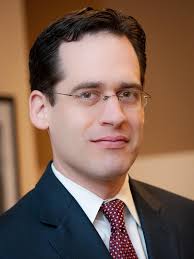
JET alum Richard Fontaine (1997-98), President at the Center for New American Security, outside advisor to Jeb Bush, and former security advisor to Sen. John McCain
A great article on the foreign policy advisors to several Republican candidates, including JET alum Richard Fontaine–outsider foreign policy advisor to Jeb Bush and former security advisor to Sen. John McCain–who is featured and quoted extensively in the article.
“Between Iraq and a Hawk Base”
http://www.nytimes.com/2015/09/06/magazine/between-iraq-and-a-hawk-base.html?_r=0
Photography Package Tours to Tohoku, Japan
Posted by Eden Law, 2010-2011 ALT Fukushima-ken, President of JETAANSW.
As part of the drive to promote tourism to Japan (not to mention combining a long-held passion and dream), ex-JET Julius Pang introduced a Tohoku photography tour to showcase the beauty of Japan in autumn, in an area that sadly has become known for other things in recent years. Americans are especially well-suited to taking advantage of this tour package, considering how strong the US dollar is against the Australian (yes, Julius’s Australia-based company, Incredible Photo Tours, welcomes overseas clients), travel will be especially cheap, with accommodation, transport and food taken care of.
Starting from Tokyo, the tour goes to various places throughout Tohoku such as Zao Onsen, Sendai, Hiraizumi, Akita, Bandai, Aizu-Wakamatsu, Nikko, Naruko Gorge, Shirakami Sanchi, Hirosaki, Nyuto Onsen and Lake Towada. With the advantage of the inside knowledge of an ex-JET, and the expertise of a tour guide who has won awards for his photography, it’s a great tour package to consider for your next trip to Japan. Julius also has other tours, such as the Japan Classic Autumn tour, that does the classic route of Tokyo, Hakone, Himeji, Kyoto, Hiroshima, Miyajima, Okayama, Takamatsu, Mt Koya and Osaka.
For more information, check out the Tohoku Autumn Tour, or the Classic Autumn Tour at Incredible Photo Tours.
Emily Metzgar’s op-ed: “The JET Program and the US-Japan Relationship”
A great summary of the long-term value of the JET Program (i.e., Return on JET-vestment) by University of Indiana journalism professor (and JET alum) Emily Metzgar:
The JET Program and the US-Japan Relationship: Alumni of the Japan Exchange and Teaching Program are an important part of bilateral ties.
As official Washington prepares for the late April visit of Japanese Prime Minister Shinzo Abe and his scheduled address to a joint session of Congress, many aspects of the bilateral relationship between the United States and Japan will rightly be feted, including a robust strategic alliance and significant economic ties between the two nations. The visit also presents an opportunity to consider a less discussed but increasingly important aspect of the U.S.-Japan relationship writ large: The extensive – and growing – network of American alumni of Japan’s long-standing Japan Exchange and Teaching (JET) Program.
Click here to read the rest of the op-ed: http://thediplomat.com/2015/04/the-jet-program-and-the-us-japan-relationship/
Be interviewed for a book about the JET Program!
Dear American JET Alumni,
I’m writing a book about American alumni of the JET Program and the growing influence of this community on the broader US-Japan relationship. I’m a professor at Indiana University and a JET alum (Shimane, 1993-1995). I’ve already published some research about American alumni of JET and the tremendous potential of this pool of college educated people with on-the-ground experience in Japan. My book will document that influence in a variety of contexts — political, cultural, educational, corporate, etc.
As I work on this book I need your help. I’m interested in talking with American alumni about the various ways they remain involved with Japan after finishing their tenure with JET. Would you be willing to be interviewed for this project?
I’ve set up an online data collection site and am asking that alumni who are willing to be interviewed use that link to provide a few details about themselves so I can determine whom to contact and when, based on my research timeline. This project is authorized by my university’s Institutional Review Board (IRB) and as the first item at the link below indicates, all safeguards associated with such university-approved research are in place.
If you’re willing to share your post-JET experiences and your insights about the growing influence of the American JET alumni community please click on this link (http://bit.ly/1Fvjvof) and provide the requested information (name, contact info, years & position on JET, current job, and nature of continued involvement with Japan). I will follow up with you soon to set up a phone or Skype interview.
If you have any questions about this request or if you’d just like to know more about this book project — I’m always happy to talk about it! — please don’t hesitate to get in touch.
Thanks so much for any insights you can share. I’m looking forward to hearing from you.
Sincerely,
Emily
Daily Yomiuri: Japanese government announces increase for JET Programme
According to a Daily Yomiuri article, the Japanese government plans to increase JET Programme participants by 2,300 between 2015 and 2019 with an eye towards eventually increasing the program to 20,000. This seems to be in line with LDP policies announced back in April.
Update 1:32 pm Sep. 22: Here’s an English version of the article:
http://the-japan-news.com/news/article/0001586882
ALTs to be placed in all primary schools
The Yomiuri ShimbunThe government has decided to increase the number of Assistant Language Teachers considerably over a five-year period, starting from the next school year, to strengthen English education at primary schools.
Aiming to create a system in which ALTs will be assigned to all public primary schools by the 2019 school year, the Education, Culture, Sports, Science and Technology Ministry, the Internal Affairs and Communications Ministry and the Foreign Ministry plan to increase the number of ALTs by about 2,300 over five years as a national project. Combined with ALTs who are hired independently by municipalities, the ministries intend to expand the total number of ALTs to 20,000, or 1.5 times the current level, by the 2019 school year.
The education ministry has decided to lower the starting age for English education from the current fifth year of primary school to the third year by the 2020 school year, and make it an official subject from the fifth year.
Experts have said it is important to secure a sufficient number of native English speakers, and utilize them to enhance the learning environments for students.
About 800 ALTs first came to Japan in 1987 when the Japan Exchange and Teaching Program was launched as a state international exchange project. As of 2002, the number of ALTs had increased to about 5,600, but it began to decrease after that due to financial problems. The current number is about 4,100.
Besides ALTs on the JET Program, about 8,000 ALTs hired independently by municipalities and other organizations have been dispatched to local primary and middle schools across the nation. In some cases, an ALT teaches at several schools.
According to experts, considerable disparity exists among the nation’s 21,000 public primary schools. While some schools have resident ALTs, some schools are visited by an ALT once about every six months.
The government therefore plans to increase the number of ALTs in the JET Program in stages. From the 2020 school year onward, English lessons will increase from the current once a week to three times a week for fifth-grade and sixth-grade students. Third-grade and fourth-grade students will have English lessons once or twice a week, and the education ministry plans to have ALTs frequently instruct students in English classes.
The budget for English education utilizing ALTs is expected to increase from about ¥30 billion this school year to about ¥50 billion a year eventually. The government also plans to launch a subsidy system for supporting municipalities that independently hire ALTs.
ALT
An ALT assists Japanese teachers in teaching foreign languages such as English at primary, middle and high schools. In addition to ALTs who come to Japan on the Japan Exchange and Teaching Program, a state international exchange project, others are directly hired by municipalities or private organizations contracted to dispatch ALTs.
From the 2011 school year, foreign language studies became compulsory for fifth-grade and sixth-grade primary school students. The role of ALTs has expanded to include assisting with pronunciation and listening comprehension.
***************
Here’s the article in Japanese. Attempted translations or paraphrases are welcome in the comments section:
全公立小に英語指導助手、5年間で2万人に
2014年09月22日 17時27分
小学校の英語教育を強化するため、文部科学、総務、外務3省は、学校で英語指導などにあたる外国語指導助手(ALT)を来年度から5年間で、国の事業だけで約2300人増員し、6400人以上とする方針を決めた。
自治体が独自に採用しているALTなどと合わせ、2019年度までに総数を現在の1・5倍の2万人に拡充し、すべての公立小学校に配置できる体制を目指す。
小学校の英語教育では、文科省が20年度をめどに、開始時期を現在の5年生から3年生に引き下げ、5年生からは正式な教科にする方針を固めている。質の高い学習環境を整える上で、英語を母国語とするALTの確保や活用が課題として指摘されていた。
ALTは、国の国際交流事業(JETプログラム)が始まった1987年に約800人が来日し、2002年に約5600人となったが、その後財政難で減り、現在は約4100人。ほかに、自治体の独自採用などで、約8000人が各地の小中学校などに派遣されている。全国の公立小学校(約2万1000校)では常駐する学校もあるが、1人で数校を受け持つケースもあり、半年に1回程度しか派遣を受けられない学校もあるという。
Donate to help disaster victims in Hiroshima!
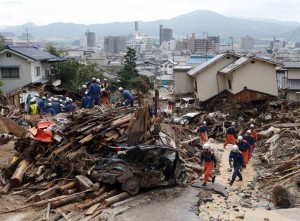 Donate to help disaster victims in Hiroshima!
Donate to help disaster victims in Hiroshima!
The death toll from mudslides in the city of Hiroshima jumped to 71 recently, with at least 15 people still missing. Nearly 1,000 people out of about 1,300 evacuees are sheltered in nine local elementary schools:
http://www.japantimes.co.jp/news/2014/08/27/national/hiroshima-slide-toll-rises-66-dead-21-missing-mayor-admits-delayed-alert/#.VAAfDPldV8E
Hiroshima Kenjin Kai of Southern California has formally joined the efforts of Hiroshima Prefecture and various Hiroshima-based NGOs and NPOs in the effort to raise funds in support of the victims of the disaster that befell the local community and residents of northern Hiroshima.
Anyone interested in joining in this effort, please send donations to:
Hiroshima Kenjin Kai of Southern California
(payable to “Hiroshima Kenjin Kai of SC”; write “JET Program Alumni – Hiroshima Relief” in memo)
Attention: Mr. Takami Igawa – HKSC President
712 East First Street
Los Angeles, CA 90012
This fundraising drive will be carried through the end of September (September 30, 2014).
All funds collected in this drive will be sent to Japan Red Cross Hiroshima Office for distribution to the disaster victims.
For any inquiry, please contact Dr. Charles Igawa, HKSC Secretary via email at <icigawa@gmail.com> or via (562) 818-7857.
Yvonne Thurman-Dogruer (Kagoshima-ken, 1994-95) is a former JETAANY President and Treasurer. She has a Master of International Affairs degree from Columbia University, had a ten-year career at its Center on Japanese Economy and Business, and ran her own business for a number of years. Yvonne currently consults for small businesses and start-ups while continuing the full-time job-search, and is an avid sailor.
JETAA NY President in 1999. Columbia grad in 2002. Director at Columbia Business School in 2005. Entrepreneur and business owner in 2008. Now? Unemploy ed.
ed.
Rarely do I say that I’m unemployed. That’s never my response when someone asks what I do. I’m consulting. I’m job-searching. I work from home. All true. I don’t know how to relate to ‘unemployed’ as a status. It’s easier on the ego to instead talk about what I’ve done up until this point. But after a year and a half with no steady paycheck, there is no doubt I am one of the many unemployed in this country, regardless of how the U.S. Bureau of Labor Statistics might choose to define me. I do consulting work when I can get it, and I continue to look for a full-time, salaried position. I am unemployed.
This summer marked a couple of milestones in my life; 25 years since graduating high school, and 20 years since I was on the JET program. I’ve attended really great reunions — hours full of fun and therapeutic reminiscing about the past. I would come home from them feeling good about reconnecting with those who had played an important role in my personal and professional growth, and proud of the many things I’ve accomplished in life so far. And then comes the question, “where am I now?”. That has me stumped. What are these invisible barriers holding me back from moving forward? This all feels so foreign to me, as I had always felt grounded in my professional life. Every day is a challenge to keep steady, strong, and navigate myself through such an unpredictable environment. And every day, I seem to get through, and continue to look for that thing called a job to give me some sense of stability.
So I chatted with Steven Horowitz a few months back and with his encouragement decided to write for JETwit and reflect on this past year-and-a-half of my professional life, and make some observations about this job market. It’s my hope that while I continue zig-zagging through the murky waters of the New York job hunt and share my experiences, it might help my fellow JET alumni who are going through the same thing. Whether you’ve returned from your Japan stint some decades ago like me, or have come back more recently, if you are job searching now – you will have a voice to contribute here. I do not aim to give advice, only to encourage discussion. Let’s start talking, continue to keep our heads about us, and our humor. Stay tuned…
CLAIR Magazine “JET Plaza” Series: Laurel Stevens Lukaszewski (Kagoshima)
Each month, current and former JET participants are featured in the “JET Plaza” section of the CLAIR Forum magazine. The July 2014 edition includes an article by JET alumnus Laurel Stevens Lukaszewski. Posted by Celine Castex (Chiba-ken, 2006-11), currently programme coordinator at CLAIR Tokyo.
***********
Laurel Stevens Lukaszewski (Kagoshima-ken, Minamitane-cho, 1990-92), is a professional artist who has shown her work throughout the US and in the UK. She is also the former executive director of the Japan-America Society of Washington, DC and is currently project director for the United-States Japan Bridging Foundation’s JETAA Initiative. Since 2002 she has been a member of the National Cherry Blossom Festival’s Board of Directors. Raised on both the east and west coasts of the US, Ms. Lukaszewski holds a bachelor’s degree in International Affairs and a master’s degree in Asian Studies from Florida State University. She lives in the DC metro area with her husband and two rambunctious cats. To view her artwork, please visit www.laurellukaszewski.com
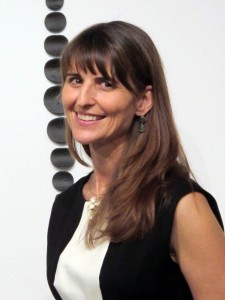
My JET experience taught me I could live in a world where I did not necessarily understand everything, but could still cope and thrive.
Enduring Connections
Twenty-four years ago I interviewed for the JET Programme in Atlanta, on my birthday. I felt this was a good omen, so I was not nervous even though this was my first professional interview. Despite spending the last two years of college studying all things Japanese, from language to religion, I had no personal connection with the country and had never been there. What was merely acting on a brief comment by a Japanese politics professor about an opportunity to teach in Japan led me down a path that has guided me over the past two decades.
I spent my two years on JET as the first Assistant English Teacher to be assigned to the town of Minamitane-cho, on Tanegashima, an island off of the southern tip of Kyushu in Kagoshima-ken. I taught at five junior high schools and visited eight elementary schools, usually the first foreigner any of the students had ever met. My role in class varied depending on the school, but every teacher I worked with was eager to include me in activities ranging from PTA BBQs to harvesting sugar cane with students.
During my first weeks I experienced two homestays before moving into my own apartment. In Kirishima, a beautiful mountain town overlooking the Sakurajima volcano, I stayed with a family with three school-age daughters. I did not know at the time that they would become my Japanese family, that their home would become mine whenever I returned to Japan, even decades later. Arriving in Minamitane-cho, I had a second homestay. And, once again, I had no idea that this young couple with three-year-old twins would end up being lifelong friends, attending my wedding, sending seasonal messages as the twins grew into young adults, and hosting my husband and me years later when we were stranded in Kagoshima by a typhoon.
One of the wonderful things about JET is it allows you to become part of the community. Whether anticipated or not, you become involved in the lives of your neighbors, teachers and students. When an art teacher learned my hobby was pottery, she invited me to visit her studio even though she did not speak English. Every week I would join another teacher and my neighbor and spend the evenings working with clay and chatting—an immersion experience in neighborhood news and gossip. When I returned to the US, it was these memories of Japan that endured. My experience taught me I could live in a world where I did not necessarily understand everything, but could still cope and thrive. Read More
JQ Magazine: JQ&A with Harry Hill, Chairman of CULCON
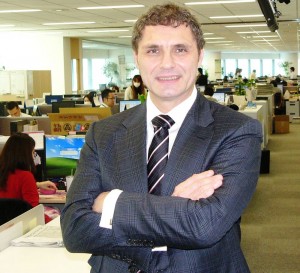
“My advice to the JETs is, don’t be afraid to take center stage and be memorable (of course in a respectful way), because these seemingly random relationships or encounters can be the source of great opportunity.” (Courtesy of Culcon.jusfc.gov)
By Alexis Agliano Sanborn (Shimane-ken, 2009-11) for JQ magazine. Alexis is a graduate of Harvard University’s Regional Studies—East Asia (RSEA) program, and currently works as an executive assistant at Asia Society in New York City.
As a martial artist, Monbusho Fellow, JET, consultant and CEO, there seems little that Harry Hill (Gifu-ken CIR, 1987-88) has not done or experienced when it comes to U.S.-Japan relations.
Now, Hill can add another feather to his cap: last February, the Japan-U.S. Friendship Commission and CULCON (the Conference on Cultural and Educational Interchange) in Washington, D.C. appointed him has their new chairman. For those familiar with Hill and his history, this appointment comes as no surprise: Hill knows Japan as intimately as he knows America. He began his career there as a Monbusho English Fellow in the mid-’80s and then served as a JET in Gifu Prefecture, experiences that helped him to tap into hitherto unexplored entrepreneurial sectors, in particular sports-related infomercials.
Since 2006, his company, Oak Lawn Marketing has been the largest infomercial brand in Japan. If you’ve seen Billy’s Bootcamp advertised there, you have Hill to thank for. Now back stateside, Hill uses his broad background in education, culture, business and non-profits to further strengthen interpersonal understanding between the U.S. and Japan. JQ caught up with Hill at his new digs—asking about life, opportunities and the risks that inevitably lead to his success.
Could you explain your background with Japan?
I developed a passion for martial arts, budo, and Shorjinji Kempo, in particular, during my time at college. This passion creates a curiosity and interest in Japan. During the summer of my sophomore year, I spent several weeks imagining my future. One of the books that influenced me at the time was Japan as Number One by Ezra Vogel. Looking around my immediate peers and acquaintances, I knew very few people who knew about Japan or could be considered Japan experts. Yet, many smart and respectable people were stating that Japan and Asia was the next land of opportunity. So I decided to start Japanese language training in my junior year with the intent of finding opportunity in Japan.
How did your time as a Monbusho English Fellow and JET lead to a career as an entrepreneur?
I was an MEF in Gifu Prefecture from 1985-1987 and the first CIR in Gifu during the first year of the JET Program from 1987-1988. As an MEF, I worked at both the kencho and kyoiku center. At the kyoiku center I helped put together teacher training programs for English teachers. In my two years in Gifu, I probably met and helped with training probably almost every junior high school or high school teacher in Gifu. I was also essentially a one-shot teacher. During my two year stint, I visited something like 230 of about 240 junior high schools and high schools, hence my job was more of a cultural ambassador who offered exposure to the English language and U.S. culture.
In 1988, Gifu hosted a regional exposition “Mirahaiku.” Since I also had a desk at the kencho, I was asked by the general affairs division to make the English name for the expo, which I named “Future Watch ’88.” The English name received a significant amount of press coverage, more from local media and to a lesser extent English language media, but inspired the organizers that the expo should have an international flavor. As a CIR from 1987-1988, some of my main responsibilities was to work for the planning organization for the expo, which was a hybrid of individuals seconded from both business and government. The expo was a great success, and the network of business leaders and government leaders with whom I worked side by side gave me the confidence that I could do business and open doors if I started my own business.

